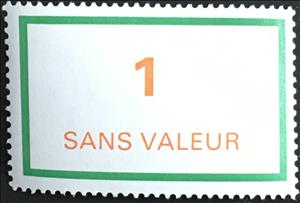Stamp: Timbre fictif de cours d'instruction (France 1978)
Timbre fictif de cours d'instruction (France 1978)
01 January (France ) within release Fictif goes into circulation Stamp Timbre fictif de cours d'instruction face value 1 French franc
| Stamp Timbre fictif de cours d'instruction in catalogues | |
|---|---|
| Yvert et Tellier: | Yt: FR F212 |
Stamp is horizontal format.
Also in the issue Fictif:
- Stamp - Timbre fictif de cours d'instruction face value 0.70;
- Stamp - Timbre fictif de cours d'instruction face value 3;
- Stamp - Timbre fictif de cours d'instruction face value 15;
- Stamp - Timbre fictif de cours d'instruction face value 1.70;
- Stamp - Timbre fictif de cours d'instruction face value 5;
- Stamp - Timbre fictif de cours d'instruction face value 1;
- Stamp - Timbre fictif de cours d'instruction face value 2;
- Stamp - Timbre fictif de cours d'instruction face value 0.50;
- Stamp - Timbre fictif de cours d'instruction face value 0.70;
- Stamp - Timbre fictif de cours d'instruction face value 1.20;
- Stamp - Timbre fictif de cours d'instruction face value 15;
|
Data entry completed
83%
|
|
|---|---|
| Stamp Timbre fictif de cours d'instruction in digits | |
| Country: | France |
| Date: | 1978-01-01 |
| Size: | 400 x 250 |
| Perforation: | 13 |
| Emission: | Other |
| Format: | Stamp |
| Face Value: | 1 French franc |
Stamp Timbre fictif de cours d'instruction it reflects the thematic directions:
A number is a mathematical object used to count, measure, and label. The most basic examples are the natural numbers 1, 2, 3, 4, and so forth. Numbers can be represented in language with number words. More universally, individual numbers can be represented by symbols, called numerals; for example, "5" is a numeral that represents the number five. As only a relatively small number of symbols can be memorized, basic numerals are commonly organized in a numeral system, which is an organized way to represent any number. The most common numeral system is the Hindu–Arabic numeral system, which allows for the representation of any non-negative integer using a combination of ten fundamental numeric symbols, called digits. In addition to their use in counting and measuring, numerals are often used for labels (as with telephone numbers), for ordering (as with serial numbers), and for codes (as with ISBNs). In common usage, a numeral is not clearly distinguished from the number that it represents.
Philately (/fɪˈlætəli/; fih-LAT-ə-lee) is the study of postage stamps and postal history. It also refers to the collection and appreciation of stamps and other philatelic products.While closely associated with stamp collecting and the study of postage, it is possible to be a philatelist without owning any stamps. For instance, the stamps being studied may be very rare or reside only in museums.


